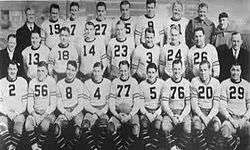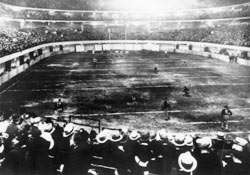1932 NFL Playoff Game
|
The indoor field at Chicago Stadium | |||||||||||||||||||
| |||||||||||||||||||
| |||||||||||||||||||
| Date | December 18, 1932 | ||||||||||||||||||
|---|---|---|---|---|---|---|---|---|---|---|---|---|---|---|---|---|---|---|---|
| Stadium | Chicago Stadium, Chicago, Illinois | ||||||||||||||||||
| Referee | Bobby Cahn | ||||||||||||||||||
| Attendance | 11,198 | ||||||||||||||||||
The 1932 NFL Playoff Game was an extra game held to break a tie in the 1932 season's final standings in the National Football League. It matched the host Chicago Bears and the Portsmouth Spartans. Because of snowfall and anticipated extremely cold temperatures in Chicago, Illinois, it was moved indoors and played at the three-year-old Chicago Stadium on December 18 on a reduced-size field on Sunday night.
Background
Since the NFL's first season in 1920, the league title had been awarded to the team with the best regular season record based on winning percentage with ties excluded. Four of the first six championships were disputed, but only in 1921 did two teams ever finish tied atop the standings: the two teams disputing the title had played each other, splitting a two-game series, but league officials used a tiebreaker to controversially give the Bears (then known as the Staleys) the title over the Buffalo All-Americans.
In 1932, the Spartans and the Bears tied for first place with 6-1 records. [1] Under the rules at the time, standings were based on winning percentage with ties excluded from the calculation, meaning that the Spartans and Bears each finished the regular season with identical .857 winning percentages, ahead of the defending champion Green Bay Packers' .769 (10 wins, 3 losses) winning percentage.
Had pure win-loss differential or the post-1972 method of calculating winning percentage (counting ties as half-a-win, half-a-loss) been used at that time, the Packers' record 10–3–1 (.750, +7) would have won them a fourth consecutive championship, ahead of the Spartans' 6–1–4 (.727, +5) and the Bears' 6–1–6 (.692, +5).[2] The Packers controlled their own destiny at the end of the 1932 season, but lost their final two games to the Spartans and Bears.[3][4]
Further complicating matters, the Spartans and Bears had played and tied each other twice during the regular season, rendering the league's only tiebreaker useless. So, for the first time, the league arranged for what amounted to a replay game to determine the NFL champion.
Because the game was counted in the final standings, the loser would drop to 6–2 (.750) and finish third, behind runner-up Green Bay. The league had to make a rule change to allow the game, since they had banned the practice in 1924.[5]
Indoor field
The game was set to be played at Wrigley Field, the Bears' home stadium, but due to severe blizzards followed by extremely cold temperatures and wind chill, the game was moved indoors to Chicago Stadium.[6][7][8][9][10][11]
Two years earlier, the Bears and Cardinals had played a charity exhibition game at the arena,[8] after the 1930 season.[12] The game was moved indoors primarily to ensure adequate attendance and gate revenue.[13]
Because of the limited dimensions of the indoor arena, special rules were adopted for the game: the tanbark-covered field itself was only 80 yards long (60 yards between the goal lines)[14][15] and 45 yards wide, 10 yards narrower than the regulation width at the time.[10] The sidelines were butted up against the stands. The goal posts were moved from the endlines to the goal lines. The ball was automatically moved back 20 yards every time one team crossed the 10-yard line.[8] For the first time, all plays started with the ball on or between the hash marks, which were ten yards from the sidelines. Additionally, drop kicks and field goals were banned.[16]
Game summary
| 1 | 2 | 3 | 4 | Total | |
|---|---|---|---|---|---|
| Spartans | 0 | 0 | 0 | 0 | 0 |
| Bears | 0 | 0 | 0 | 9 | 9 |
at Chicago Stadium, Chicago, Illinois
- Date: December 18
- Game time: 8:15 p.m. CST
- Game weather: Indoors
- Game attendance: 11,198
- Referee: Bobby Cahn
- Boxscore
| Game information |
|---|
|

With terrible footing on the mulch and limited room for the offenses to work, the defenses dominated the game's first three quarters, and the game remained scoreless.[17] In the fourth quarter, the Bears scored on a controversial touchdown: Carl Brumbaugh handed the ball off to fullback Bronko Nagurski, who pulled up and threw to Red Grange in the end zone for the score.[18] Rules at the time mandated that a forward pass had to be thrown from at least five yards behind the line of scrimmage. The Spartans argued that Nagurski did not drop back five yards before passing to Grange, but the touchdown stood. The Bears later scored a safety after the Spartans fumbled the ball out of their end-zone.[18][16]
The high temperature for that Sunday in Chicago was 20 °F (−7 °C),[19] warmer than anticipated earlier in the week.
Officials
- Referee: Bobby Cahn
- Umpire: G.A. Brown
- Head Linesman: Meyer Morris [17]
Legacy
Because it proved so popular, the 1932 NFL Playoff Game started a new era for the National Football League and for American football in general. Through 1932, the league had used the same rules as college football. Beginning with the 1933 season, the NFL introduced its own set of rules. The goal posts were moved from the end line back to the goal line (reversed in 1974), the forward pass became legal anywhere behind the line of scrimmage, and all plays started with the ball on or between the hash marks.
In 1933, the NFL expanded to ten teams and divided into two divisions. The division winners met in a scheduled championship game to determine the NFL champion.
The 1932 NFL Playoff Game is also regarded as the first major indoor football game, a variation of American football with rules modified to make it suitable for play inside arenas. While several attempts to develop a true indoor football game have been made since then, the only version to meet with anything resembling true success and acceptance has been arena football.
References
- ↑ "Pro standings". Milwaukee Sentinel. Associated Press. December 12, 1932. p. 11.
- ↑ Kuechle, Oliver E. (December 13, 1932). "Pro football league will change system of rating teams in 1933". Milwaukee Journal. p. 6, part 2.
- ↑ McGlynn, Stoney (December 12, 1932). "Bears whip Packers, 9-0, tie for pro title". Milwaukee Sentinel. p. 11.
- ↑ Kuechle, Oliver E. (December 12, 1932). "Packers lose to Chicago Bears on snow-covered field, 9-0". Milwaukee Journal. p. 4, part 2.
- ↑ http://profootballresearchers.org/Coffin_Corner/02-08-037.pdf
- ↑ Smith, Wilfrid (December 16, 1932). "Bears battle with Spartans moved indoors". Chicago Tribune. p. 25.
- ↑ "Bears, Spartans to play indoors". Milwaukee Journal. Associated Press. December 16, 1932. p. 7, part 2.
- 1 2 3 "Bears vs. Spartans". Milwaukee Journal. United Press. December 18, 1932. p. 1B.
- ↑ "Pro gridders meet tonight in Windy City". St. Petersburg Times. Associated Press. December 18, 1932. p. 2, section 2.
- 1 2 Dunkley, Charles W. (December 19, 1932). "Bears beat Spartans, 9-0; win pro title". Milwaukee Sentinel. Associated Press. p. 13.
- ↑ Williams, Marty (January 15, 1978). "Today's game not first indoors". Daily News. Bowling Green, Ohio. (Dayton Daily News). p. 12.
- ↑ "Pro teams play indoor grid game". Milwaukee Sentinel. Associated Press. December 15, 1930. p. 2, Final.
- ↑ Smith, Wilfrid (December 18, 1932). "Bears battle Spartans for title tonight". Chicago Tribune. p. 1, part 2.
- ↑ Kuechele, Oliver E. (December 19, 1932). "The Bears won, 9-0, but what was it all about?". Milwaukee Journal. p. 6, part 2.
- ↑ "Bears battle for pro title". Milwaukee Sentinel. Associated Press. December 18, 1932. p. 2B.
- 1 2 Mayer, Larry (March 1, 2014). "Bears played NFL's first indoor game". Chicago Bears. Retrieved March 1, 2014.
- 1 2 Smith, Wilfrid (December 19, 1932). "Bears win, 9-0; pro football champions". Chicago Tribune. p. 19.
- 1 2 "Chicago Bears pro champions". Pittsburgh Post-Gazette. (Chicago Tribune). December 19, 1932. p. 14.
- ↑ "The Weather". Chicago Tribune. December 19, 1932. p. 1.
External links
- Pro Football Hall of Fame: The First Playoff Game (Retrieved September 23, 2005)
Coordinates: 41°52′55″N 87°40′23″W / 41.882°N 87.673°W
